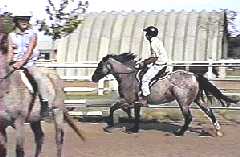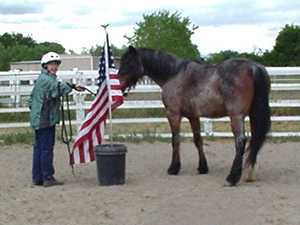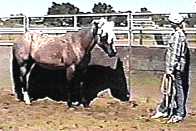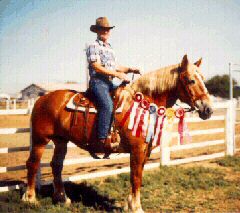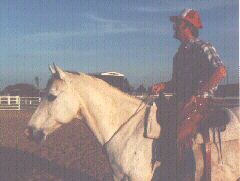|
We have found two basic schools of thought in training. One is the school of control. The other runs in the direction of such methods as "natural horsemanship." Natural horsemanship may be a popular term now, but the concept is far from new, extending its roots as far back as 540 BC in Persia. Natural horsemanship has in itself a number of sub-cultures. Some of these sub-cultures actually drift away from the underlying principles of natural horsemanship.Ours is based on the premise that certain events will help the horse learn and respond quickly, and these events can be carried out safely by people who in fact have limited horse experience. We're not putting on big clinics and symposiums showing off a bunch of advanced stuff. We're dealing with basic principles here; principles which have been around for centuries, which you can apply, and will provide both you and your horse a solid foundation upon which to grow. Then you will be ready to go to the high priced symposiums and clinics and really understand what's going on. In the meanwhile, you can have this stuff for free!
Learn-Learn isn't intentionally wearing the horse down by longeing, running, etc., so that one can train or handle him. It's setting up the training environment so that the horse can and will learn, even when he is fresh, which takes advantage of his sharper state of mind. We may often give a horse some time to "loosen up," but we never want to tire him out. We want his energy available so that we can redirect it toward learning and so he won't move sloppily and perhaps hurt himself. We also to generate uncontrolled stress. Social interaction among free-roaming horses involves various degrees of stress so stress in of itself isn't necessarily bad. However a horse can easily reach a stress level where it reacts rather than responds to the trainer's stimulus. Such reactions are more volatile and usually don't result in the horse learning anything meaningful from our point of view. Responses, in contrast, are more thoughtful and are more relevant to the horse actually learning what it is that we want him to. Therefore we want at all times to avoid "relentless pressure" situations but rather set up training conditions where the horse can, through cause and effect repetition, grasp what it is that we are asking. Furthermore, oftentimes the horse has to make some mistakes in order to recognize the right answer. That recognition comes from our ability to make the horse's wrong ideas difficult and the right ideas easy. We describe letting the horse make choices, but Learn-Learn isn't letting the horse simply do what he wants. Control freaks don't like the Learn-Learn concept, but we have found that a thinking horse is safer and easier to handle than a reactive horse. Thus we teach him to make decisions (choices). By structuring this process we encourage him to learn. We're not spoiling him. We simply narrow down the menu of choices that we offer him to include only what we want. Learn-Learn isn't "letting the poor horsey walk away or stop working if he wants to." It is applying that ancient principle of making it difficult for the horse to make the wrong decision and making it easier to make the right one. The premise is incredibly simple. The handler still controls the horse, but he controls it through the horse's mind, not with ropes or whips. The horse's mind is a much more powerful tool, however the trainer does have to be smarter than the horse for this to work!
Learn-Learn is a process of engaging the horse's mind. It does several things. It lets the horse participate, which reduces tension. It teaches the horse to think rather than react. Therefore it increases the interval between the horse observing something which disturbs it and its reaction (or response) to it, allowing the less experienced handler more time to make a correction. Learn-Learn is not wasting time locked in a battle of wills with a shy or balky horse. The horse weighs many times that of the handler and to get engaged in a pulling contest or battle of wills makes absolutely no sense. Once the horse is angry or emotional, he is less likely to absorb and process any more than the most basic elements of what he is being taught. Learn-Learn is a dynamic interplay between the horse and handler. Therefore the handler is responsive to the body language of the horse in addition to the horse's response to the handler. This teaches less experienced handlers to more accurately "read" the horse. The combination of a less reactive horse and a handler who has a better clue as to what is going on provides increased safety and a much faster learning curve.
Other choices include such things as proper behavior or work. For example, the horse must stand quietly to be bridled. This is the desired behavior. Should he choose to leave, we allow him to do so, however the results of that choice will be that he is immediately sent off to work. (He can learn to deal with the problem, or he's going to learn something which requires effort; Learn-Learn... no wasted time.) It doesn't take horses long to figure out that it's much easier to hang out with the handler and deal with whatever problem he's being presented.
A thinking horse can learn faster. He is focused, is less disturbed or distracted by other noises, activities, etc., and is used to using his mind. He has a desire to follow and this desire has been stimulated through the offering of choices, not by force. As a result, it is a more willing participation on the part of the horse.
A thinking horse requires less "containment." He is taught to think in terms of his working relationship with his handler. This reasoning ability carries over into the saddle where the horse can perform with a minimum of guidance because he is used to "reading" his rider, not being controlled. Thus you have two minds working on performance instead of one. It's called teamwork, and it's pretty cool stuff.
The point is this. You can choose to use the horse's mind as a tool or you can choose not to. The choice is yours. Should you wish to tap into this power, look through the pages in this site. We'll show you what it's all about and it won't cost you a dime!
(I posted the following to the wildhorse newsgroup and I thought it was worth saving.) This is why we try our best to emphasize the relationships between the handlers' actions and the horses' responses. Unless you're going to only work one horse the rest of your life, you can't memorize patterns per se but rather you have to understand the concepts. Then you won't stall out when something you attempt doesn't work but can instead make adjustments based on how you see the horse responding to you. This is also why we try to teach the horses to think! We don't want them stalling out over a confusing item and possibly react or panic. We want them to absorb the stimulus from the handler or rider and make a rational decision in response to it. This is one of the big differences between "open" and "control oriented" training. The controlling handler gives a specific aid and punishes the horse for making a mistake. The open trainer wants the horse to think, learn to perceive the aids, etc., and simply says "no, wrong answer" by putting the horse to work when he does make a mistake. We don't want the horse to be afraid to think because the wrong answer brings with it retribution. Now, when the horse is thinking, one can start narrowing down the decision "bandwidth" to more specific responses. The horse is still looking for the answer and as he becomes more experienced and more physically fit, he becomes more consistent and faster at recognizing the aids and responding correctly to them. It's a natural progression. Most dressage horses in my region are "Nervous Nellies." I don't think they have to be. Some of these people are my friends and it slays me that they're always impressing on me how they want flowing, relaxed carriage and fluidity from their horses while all the time they're smacking the Hell out of them with a crop. To me that's like trying to get to the second floor of the department store by walking up the down escalator. Sure you can do it, but why expend all the extra effort? Work with the horse for what he is. Help him through his difficulties and take advantage of his strengths. You'll have a lot more fun, your horse won't be wasting half his energy on stress, he'll have a lot more fun, and if you're good at your discipline, you'll get "there" faster anyway... plus you will have enjoyed the journey in the process. Return to Open Training and setting up Learn-Learn SituationsPress "Back" to return to the page that brought you hereGo to Case Study SectionReturn to Training SectionReturn to Wild Horse MentorsReturn to KBR World of Wild Horses and BurrosGo To
|


